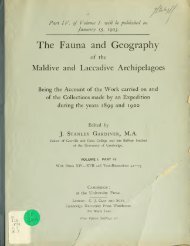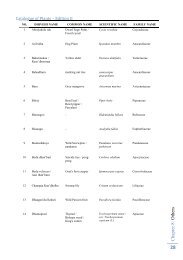Download - WordPress – www.wordpress.com
Download - WordPress – www.wordpress.com
Download - WordPress – www.wordpress.com
You also want an ePaper? Increase the reach of your titles
YUMPU automatically turns print PDFs into web optimized ePapers that Google loves.
MARINECRUSTACEANS.PARTS X.AND XLBy L. a. Borradaile, M.A., Lecturer in Natural Sciences at SelivynCollege,Cambridge.(With Plates XLVII. and XLVIII. and Text-figures 122—6.)X. THE SPIDER-CRABS (OXYRHYNCHA).The Oxyrhyncha are a fairly well characterized group. Sharply separated, on the onehand from the Dromiacea by the coxal opening of the oviduct, the loss of the firstabdominal limb in the female, and the normal shape and position of the last pair of legs(except in two or three cases as Ocinopus (Fig. 123), Grypachaeus and Zehrida), and onthe other hand from the Oxystomata by the square mouth and the normal maxillipeds(PI. XLVII. fig. 5 h), they differ from the Brachyrhyncha in the shape of the body, whichis narrowed in the fore part, so that in most cases it is triangular, and has a well-markedrostrum (PL XLVII., and Text-figs. 122 and 123), and usually in the imperfection of the orbits.Slender legs and weak chelae are another <strong>com</strong>mon feature, but not a diagnostic one. Theirprevailing habitat may be summed up by saying that they are the crabs of the weed andweed-like animals, but this statement needs some explanation and qualification.The loss of their tail-fin has left the crabs, as a whole, a distinctly slower-movinggroup than most of the tailed Reptantia. To this there are, indeed, exceptions—as, forinstance, the Ocypodes on land and the swimming crabs in the water—but for the bulkof the Brachyura it holds good, and each of the sections of the tribe has had to meetthe difficulty in its own way. In the Brachyrhyncha the cuticle has generally be<strong>com</strong>ethickened into a stout armour, while the crab keeps fairly active in its habits, at all eventsafter dusk, and usually defends itself vigorously with its strong chelae when it is attacked.In this legion protective coloration and shape are <strong>com</strong>paratively rare, and the habit ofcovering the body with foreign objects decidedly so (Caphyra), though the custom of hidingunder stones is <strong>com</strong>mon. The remaining groups have, so to say, accepted the situation.Driven by the loss of their tail-fin to lead a sluggish life, they have found safety inexaggerating this inertness and <strong>com</strong>bining it with various devices for escaping observation.The Dromiacea hold foreign bodies over their backs with their hind legs, the Oxystomesbury themselves in sand or shingle, and in each of these groups the most characteristicfeatures, to which they owe their distinctness, are due to the method of concealments The'See above, p. 434.






